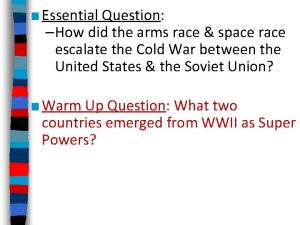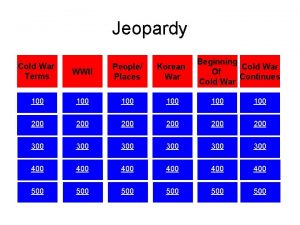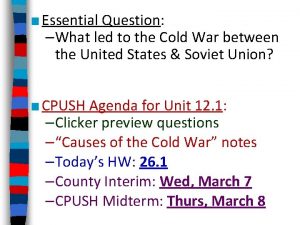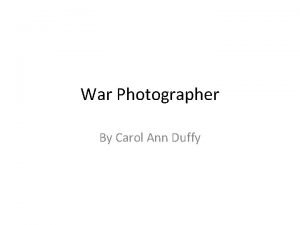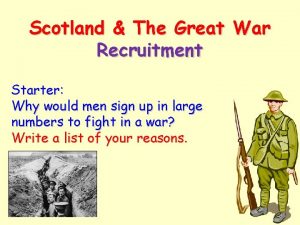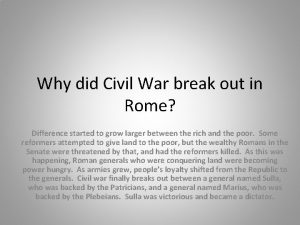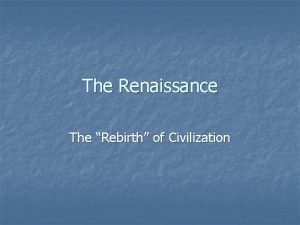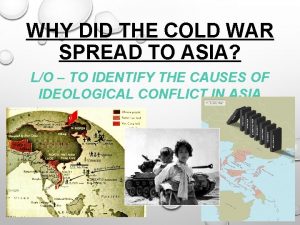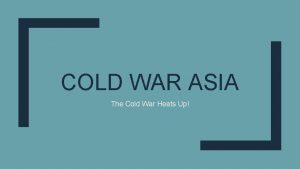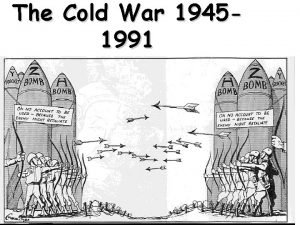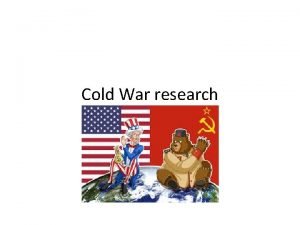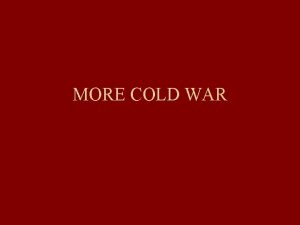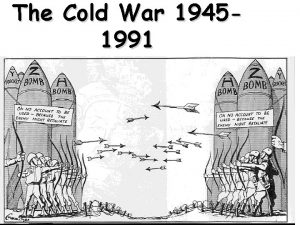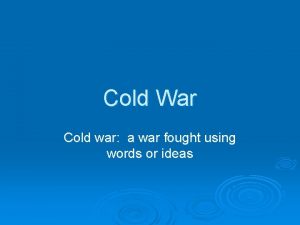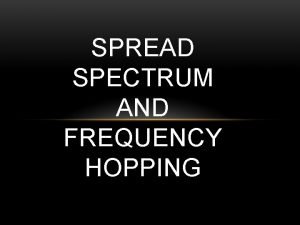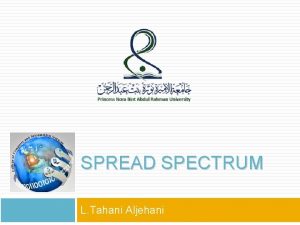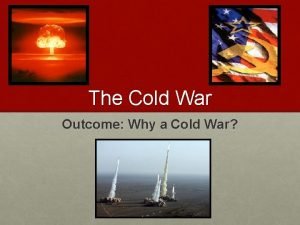Why did the Cold War spread to Asia
















- Slides: 16

Why did the Cold War spread to Asia? L/O – To identify the causes of ideological conflict in Asia

US Foreign Policy 1949 -1950 • By May 1949, the Berlin Blockade had been defeated, West Germany (FRG) had been created and the NATO alliance had formed. The USA was optimistic that Communism had been contained in Europe. • NATO ensured that Western Europe was protected against the massive Soviet army by the USA’s atomic weapons. • However by Autumn 1949, the balance of power had shifted. China fell to communism and the USSR developed its first atomic bomb.

The USSR’s First Atomic Bomb • In August 1949 the USSR developed it first atomic bomb, shattering US and NATO security. • The USA was completely taken by surprise at the speed in which the USSR had developed its atomic bomb. • The USA’s nuclear monopoly was now at an end and it could no longer use threat of nuclear weapons in foreign policy. A new balance of power emerged amongst the superpowers.

China falls to Communism • In October 1949, Mao Zedong had declared the foundation of the People’s Republic of China (PRC), establishing a communist regime across China. • During the Chinese Civil War (1945 -49), the USA had supported Chiang Kai-shek’s Nationalist government. • The communist victory took many by surprise and debate raged in American over the extent to which Truman could have ‘saved’ China.

China falls to Communism • In 1949 a White Paper was published by US Secretary of State Dean Acheson. It stated that the US could not have altered the outcome of the Civil War. • It blamed defeat on the unpopularity of Chiang Kai-shek with the Chinese people, and it was a ‘nationalist collapse’ rather than a ‘communist victory’. • The White Paper was received badly. Many in the US blamed Truman’s government for not doing enough to stop Communism in Asia.

Secretary of State Dean Acheson’s White Paper, ‘United States Relations with China’, August 1949 The reasons for the failure of the Chinese National Government appear… not to stem from any inadequacy of American aid. Our military observers on the spot have reported that the Nationalist armies did not lose a single battle during the crucial year of 1948 through lack of arms or ammunition. The fact was that the decay which our observers had detected in Chongqing early in the war had fatally sapped the powers of resistance of the Guomindang. Its leaders had proved incapable of meeting the crisis confronting them, its troops had lost the will to fight, and its government had lost popular support. The Communists, on the other hand, through a ruthless discipline and fanatical zeal, attempted to sell themselves as guardians and liberators of the people. The Nationalist armies did not have to be defeated; they disintegrated. History has proved again and again that a regime without faith in itself and an army without morale cannot survive the test of battle.

The Red Scare • The fall of China and the USSR’s atomic bomb led to fears about growing Soviet power. Anti-Communist feeling in the USA grew, and by 1950 had reached fever-pitch. • In this atmosphere, Senator Joseph Mc. Carthy of Wisconsin began alleging that the Soviet Union was conspiring to place Communist sympathisers in key positions in the USA. • His accusation led to a series of ‘purges’ and ‘show trials’. People were accused of ‘un. American behaviour’, some were executed.

The Red Scare • The period in the USA became known as the ‘Red Scare’. All elements of US society began to be viewed with suspicion. • The ‘anti-Red’ crusade shifted public opinion against Communism in America. Mc. Carthy began to accuse everyone of being Communists, including members of the US Army and State Department. • He even claimed that the Truman administration was influenced by Communism, it was being too ‘soft’.

The Red Scare • In this atmosphere, in February 1950, Secretary of State Dean Acheson was forced to publically reconsider the White Paper on China, now claiming that China under Mao was completely in league with the USSR. • State Department advisors on China who had criticised the KMT lost their jobs. Truman even began a review of US foreign policy. Under this pressure, he was unable to recognise the legitimacy of the new Chinese government.

NSC-68 – Total Commitment • NSC-68 was a report by the US National Security Council in 1950 and is seen as one of the key documents of the Cold War. • It warned that all Communist activity everywhere could be traced back to Moscow. Recent world events had a ‘global theme’ that all indicated the growing strength of the USSR. • NSC-68 represented a ‘monolithic’ view of Communism – it was all controlled by Moscow!

NSC-68 – ‘Total Commitment’ • The report went on to warn of a ‘indefinite period of tension and danger’, advising the US to by ready to meet every challenge that may arise. • To this end, it recommended the government increase its military spending by $35 -50 billion! • NSC-68 was hugely significant as it encouraged military and economic aid to be given to any country that was resisting Communism – anywhere in the world.

Secret Statement in National Security Council Report 68, State and Defense Department, Washington, April 1950: [We advocate] an immediate and large scale build-up in our military and general strength and that of our allies with the intention of righting the power balance and in the hope that through means others that all-out war we could induce a change in the nature of the socialist system… The United States… can strike out on a bold and massive program of rebuilding the West’s defensive potential to surpass that of the Soviet world, and of meeting each fresh challenge promptly and unequivocally… This means virtual abandonment by the United States of trying to distinguish between national and global security. It also means the end of subordinating security needs to the traditional budgeting restrictions; of asking ‘How much security can we afford? ’ In other words, security must henceforth become the dominant element in the national budget, and other elements mush be accommodated to it… This new concept of the security needs of the nation calls for annual appropriations of the order of $50 billion, or not much below the former wartime levels.

NSC-68 – Total Commitment • Revisionist historians have critised US perceptions of Soviet intentions expressed in the document. They argue the document rested of false premises and was just an ‘excuse’ for US expansionism. • However would America pay? The American taxpayer would have to raise huge amounts of money. • Historian William S. Taubman argues that Dean Acheson deliberately overstated the case in order to persuade the US public to agree to a rise in military spending.

NSC-68 and Asia • Facing difficult congressional elections in November 1950, and in a growing climate of fear, President Truman could not afford to be seen as ‘soft’ on Communism. • Personally, Truman was in no rush to consider committing the USA to containment on a ‘global scale’ as advocated by NSC-68. • However on 25 th June 1950, Communist North Korea invaded South Korea. The Cold War had now spread to Asia. Would Truman now try to contain it?

Containment in Asia • The North Korean attack was seen as clear Soviet expansionism and it was assumed that the North Koreans were being instructed by Stalin. • The Korean War seemed to back-up what NSC-68 predicted. Truman now feared that failure to take action would result in a ‘domino effect’. • Communism could quickly spread to other countries! The US therefore responded with the same policy it had used in Europe – containment. President Truman: If we let Korea down, the Soviets will keep right on going and swallow up one piece of Asia after another… If we were to let Asia go, the Near East would collapse and no telling what would happen in Europe… Korea is like the Greece of the Far East. If we are tough enough now, if we stand up to them like we did in Greece three years ago, they won’t take any more steps.

Why did the USA policy of containment shift to Asia after 1949?
 The cold war lesson 1
The cold war lesson 1 Why did the arms race escalate during the cold war
Why did the arms race escalate during the cold war Proxy wars in the cold war
Proxy wars in the cold war Andreas carlsson bye bye bye
Andreas carlsson bye bye bye Why did stalin want to create a “buffer zone”?
Why did stalin want to create a “buffer zone”? How long did the cold war last
How long did the cold war last Who started the cold war and why
Who started the cold war and why Spectrum spread butter
Spectrum spread butter Why was the civil war considered the first modern war
Why was the civil war considered the first modern war Context of war photographer
Context of war photographer Triple entente
Triple entente Why was josette dugas for the war of 1812
Why was josette dugas for the war of 1812 Why did england and spain go to war
Why did england and spain go to war Why did civil war break out in rome?
Why did civil war break out in rome? Where did the renaissance begin?
Where did the renaissance begin? Where did the renaissance spread
Where did the renaissance spread Origin of number system
Origin of number system

